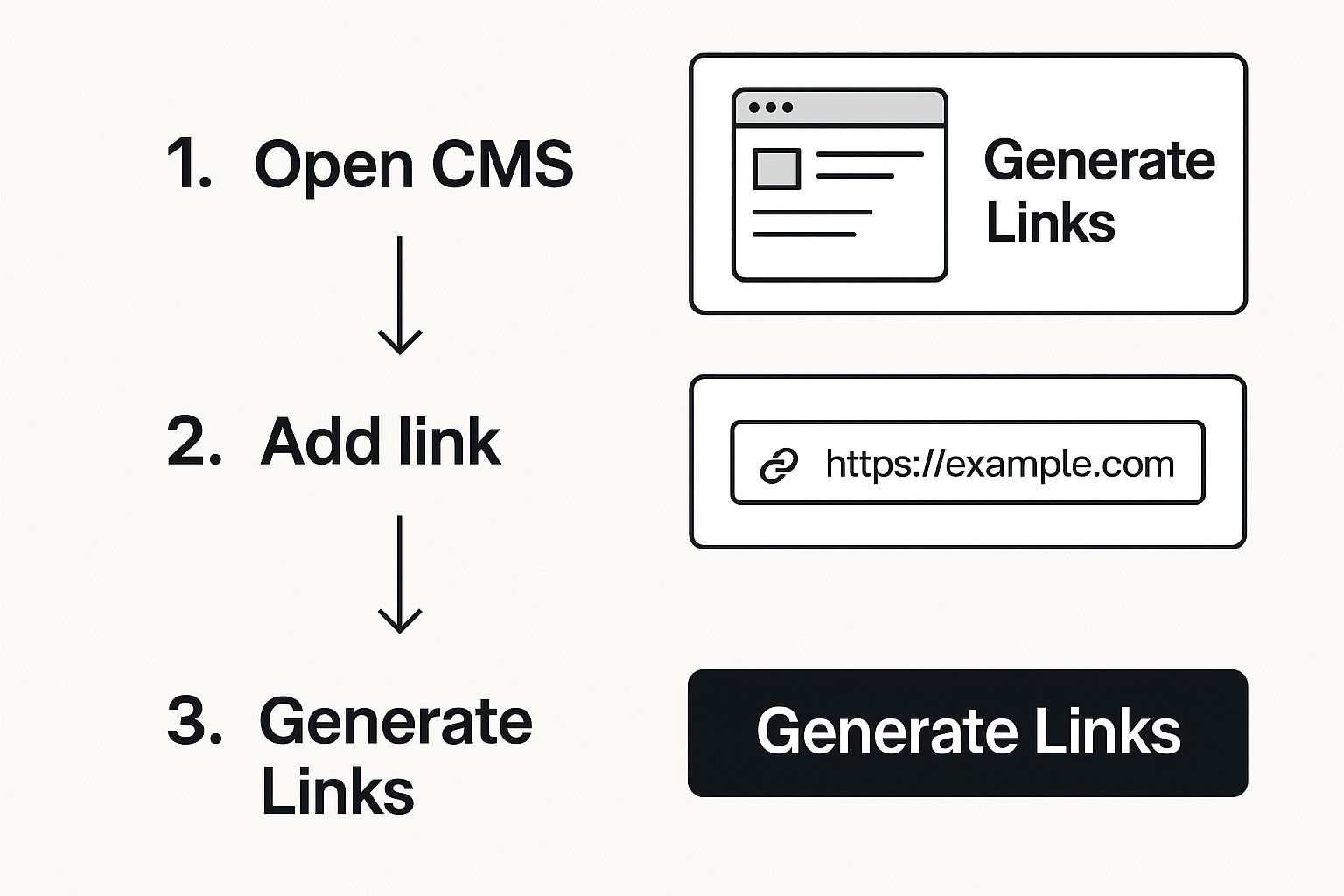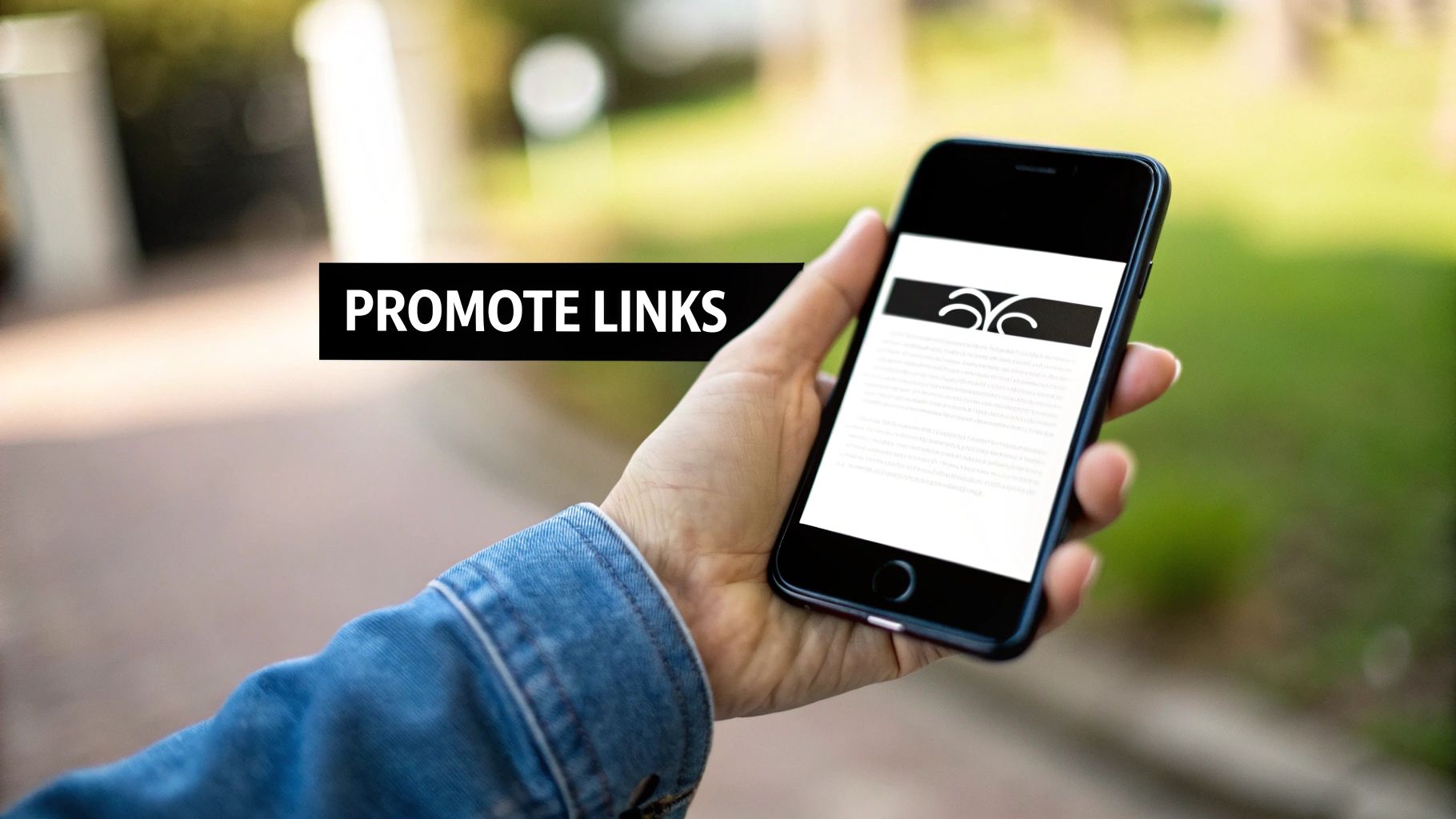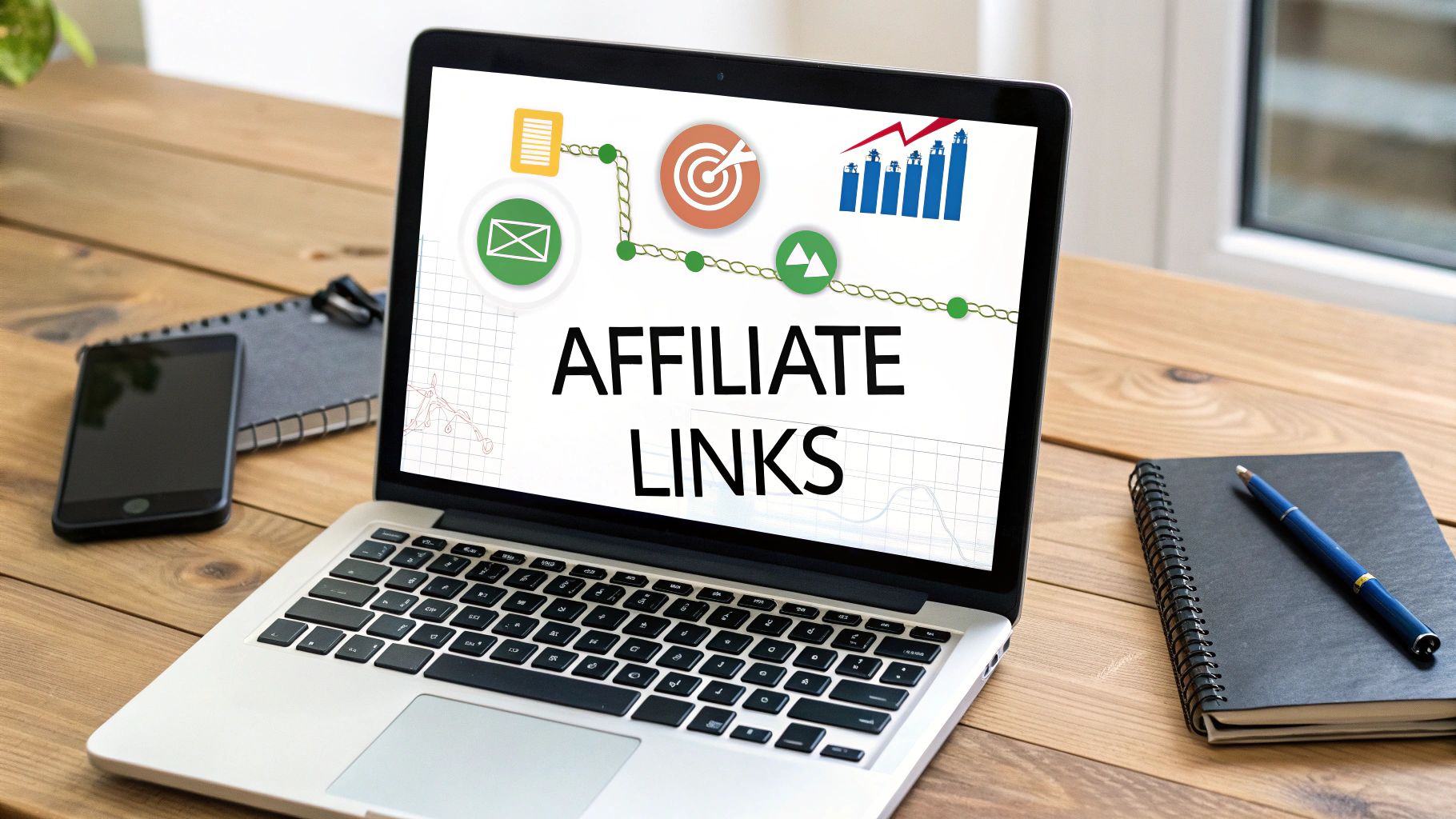Getting your first affiliate link set up is pretty straightforward on the surface: you find an affiliate program, get your special tracking link, and pop it into your content. That's the basic recipe. But if you want to move beyond just a few random clicks and actually build a reliable income stream, you need to think strategically from the very beginning.
The real art isn't just in placing links—it's in the why and how behind them.
Your First Steps in Affiliate Link Setup

While generating a link might take a few seconds, the groundwork you lay beforehand is what truly dictates your success. The choices you make about which programs to join and what products to promote will define your entire affiliate marketing journey. This isn't about grabbing any old link; it's about making smart, deliberate choices that genuinely serve your audience and fit naturally with your content.
The affiliate marketing world is huge and only getting bigger—it's projected to hit a staggering $31.7 billion by 2031. With over 40% of that revenue coming from North America, the opportunity is undeniable. To get your slice, your setup has to be more than just technical; it needs to be tactical.
You'll see giants like Amazon Associates dominating the scene with a 46.21% market share, mostly because their product catalog is endless. But that doesn't mean they're the best fit for everyone. Every successful affiliate knows that getting a unique tracking URL is the fundamental first step to making sure you get credit for every sale. If you're curious about the numbers driving this growth, you can find more insights about affiliate marketing statistics on hostinger.com.
For a quick overview of the process, this table breaks down the essential phases of getting your first link live.
Quick Guide to Setting Up Your First Affiliate Link
| Phase | Action | Key Consideration |
|---|---|---|
| Discovery | Research and select an affiliate program. | Does the product align with your audience's interests and needs? |
| Application | Apply to the program and get approved. | Have your website or platform ready to show them your value. |
| Generation | Create your unique tracking link in their dashboard. | Understand the link structure and your unique affiliate ID. |
| Placement | Integrate the link into your content. | Place it naturally where it adds value, not just as an ad. |
| Tracking | Monitor clicks and conversions in the dashboard. | Use this data to see what works and optimize your strategy. |
Following these steps will get you started, but your real momentum will come from understanding the deeper mechanics at play.
Choosing Your Starting Point
One of the first big decisions you'll make is whether to go with a massive affiliate network or a smaller, independent program. They both have their pros and cons, and your choice will shape how you operate.
Large Networks (e.g., ShareASale): These are like one-stop shops, giving you access to thousands of brands from a single dashboard. They're fantastic for beginners who want a lot of options. The setup is usually standardized, which makes juggling multiple partners much simpler.
Independent Programs (e.g., Niche SaaS): Partnering directly with a company like Refgrow often means you get higher commission rates and much more personal support. The setup might be a bit different for each one, but the potential for a stronger, more lucrative relationship is often worth it.
Understanding Core Link Concepts
Before you even think about placing a link, you have to get a handle on how they actually work. These concepts are the engine of your affiliate income, and they directly influence how you should approach your content.
Your affiliate link is more than just a URL; it’s a smart tool containing data that tracks clicks, sales, and commissions. Understanding its components—like cookie duration—is the difference between earning sporadically and building a consistent income stream.
The commission structure is simply how you get paid. Is it a percentage of the sale? A flat fee per lead? Or a recurring payment for as long as someone stays a subscriber?
Just as important is the cookie duration. This is the timeframe after a click where you're still eligible for a commission. A 30-day cookie is solid, but a 90-day cookie is even better. It gives your reader more time to think things over before buying, which ultimately gives you a better shot at earning that commission.
Finding and Joining the Right Affiliate Programs
Your journey with affiliate links really starts long before you ever copy and paste a URL. The real groundwork, the stuff that makes a difference between pocket change and a real income stream, is picking partners that genuinely resonate with your audience and your brand.
It's a classic rookie mistake: chasing the highest commission rates without a second thought for relevance. This almost always backfires, leading to dismal click-through rates and, worse, a loss of your audience's trust.
Think about it. If you run a popular blog dedicated to vegan baking, it makes absolutely zero sense to promote a steak delivery service, no matter how high the payout. Your readers won't just ignore the link; they'll question your credibility. The secret is to find products and services that feel like a natural extension of your content—things that actually help your people solve a problem.
How to Vet Potential Affiliate Partners
Before you even think about hitting that "apply" button, you need to do a little homework. Look past the big, flashy commission numbers and dig into the details that truly determine your long-term success. From my experience, there are three non-negotiable metrics to check out:
- Commission Rate: Is it a percentage of the sale or a flat fee? For anything subscription-based, find out if the commission is recurring. A 20% recurring commission on a software tool can easily outperform a one-time 40% commission on a physical product over the long haul.
- Cookie Life: This is simply the tracking window. A generous 90-day cookie means you get credit if your reader makes a purchase anytime within three months of their initial click. On the other hand, a short cookie life, like 24 hours, dramatically shrinks your window of opportunity.
- Payout Threshold: What's the minimum balance you need to hit before they send you your money? A $100 threshold can feel like a long road if you're promoting low-cost items, effectively holding your cash hostage for months.
The most profitable affiliate partnerships are built on a foundation of mutual value. You provide the company with qualified leads, and they provide your audience with a great solution while offering fair, transparent terms that make the effort worthwhile.
Affiliate Networks vs. Direct Programs
Once you know what a good partnership looks like, you can start your search. You’ll generally find two paths: joining large affiliate networks or partnering directly with individual brands. Each has its own pros and cons.
Affiliate Networks
Marketplaces like ShareASale or CJ Affiliate are fantastic starting points. They act as a one-stop shop, giving you access to thousands of brands from a single dashboard. This is a huge time-saver for managing applications and payments, especially when you're just getting started and want to test the waters with different offers.
Independent Programs
Many companies, particularly in the SaaS world, prefer to run their own programs in-house. Going direct can often lead to better commission rates, dedicated support, and a much closer relationship with the brand manager. This is also where you'll discover unique, high-value products that aren't listed on the massive networks. For more specific strategies on uncovering these gems, this guide on how to find affiliates and programs is a great resource.
When you're ready to apply, treat it like a job application. Clearly explain who your audience is and why their product is a perfect match for your content. A thoughtful application immediately sets you apart as a serious partner, not just another person looking for a quick buck. It not only gets you approved faster but also paves the way for a successful, long-term collaboration.
Getting Your Hands on Your Affiliate Links
So, you've signed up for an affiliate program. Great! Now it's time to turn that partnership into actual earning potential. This is where we get practical and create the unique links that will track every single referral you send. Honestly, this is a fundamental skill for anyone serious about making money with affiliate marketing.
Your affiliate dashboard is your command center. Every program, whether it’s on a massive network like ShareASale or run directly by the company, will have a spot for you to generate your URLs. It can feel a bit overwhelming at first, but once you find it, the process is usually pretty simple. Just look for a menu item labeled "Links," "Creatives," or something similar.
This is what the typical flow looks like. You find the tool, you generate the link, and you're ready to go.

As you can see, it’s not some complex technical feat. In just a few clicks, you have a powerful tool ready to earn for you.
Going Beyond the Basic Text Link
The simplest and most common option you'll see is a standard text link. But don't stop there. Most programs offer a variety of formats, and using them strategically can make a huge difference in your engagement and, ultimately, your conversions.
Product Image Links: Visuals grab attention. Many brands provide pre-made banners or product images with your affiliate code already embedded. They're perfect for breaking up a long article and giving your readers' eyes a place to land.
Deep Links: This is where the real magic happens. Instead of sending traffic to a generic homepage, a deep link takes a user to a specific product or sales page. If you're reviewing a single feature of a software, you should link directly to that feature’s page, not the main website. It cuts out unnecessary steps for your reader, which is always a good thing.
My Two Cents: If you can use a deep link, you should. Always. Sending someone directly to the page that solves their exact problem shows that you're focused on helping them, not just making a sale. That respect for their time builds trust and, in my experience, leads to way more conversions.
Make Your Links Clean and Trustworthy
Let's be honest, raw affiliate links are ugly. They're often long, messy strings of letters and numbers like yourwebsite.com/product?affid=123&utm_source=blog. To a savvy user, that can scream "spam" and kill their desire to click.
This is where link management plugins, like ThirstyAffiliates for WordPress, are a lifesaver. These tools let you cloak your links, transforming them into clean, branded URLs like yourblog.com/recommends/product-name. Not only does this look far more professional, but it also makes your links a breeze to manage across your entire site.
For a more detailed walkthrough, check out our guide on exactly how to create an affiliate link that is optimized for clicks.
Know What’s Working with SubIDs
How do you know which of your links are actually making you money? The link you placed in a how-to guide might be driving all your sales, while the one in your sidebar is just taking up space. This is the exact problem SubIDs were created to solve.
A SubID is just a small piece of tracking data you can tack onto the end of your affiliate link. Think of it as a custom label for every single place you put that link.
For instance, you could set them up this way:
- Link in a review post:
affiliatelink.com/product?id=yourID&subid=reviewpost - Link in a sidebar banner:
affiliatelink.com/product?id=yourID&subid=sidebar
When you check your affiliate dashboard, you'll see which SubIDs are generating clicks and sales. This data is pure gold. It tells you exactly what's working so you can stop guessing and start doubling down on the strategies that actually drive revenue.
2. Where to Place Your Links for Maximum Conversions
Setting up your affiliate links in Refgrow is just the first step. The real magic—and the real money—comes from knowing where to place them. So many people make the mistake of just scattering links randomly throughout their content, and then they wonder why they're not getting any clicks.
The truth is, success in affiliate marketing comes from placing your links where they feel like a natural, helpful part of the conversation, not a jarring advertisement.
You want your link to show up at the exact moment a reader is thinking, "Okay, I have this problem... what's the solution?" When you do that, your affiliate link transforms from a sales pitch into a genuine recommendation. It builds trust and makes people far more likely to click.
Think of it this way: if you're writing a detailed review of a product, the perfect spot for your link is right after you've explained how it solves a specific, frustrating problem for your reader. They're already sold on the benefit; you're just showing them the way.
High-Converting Placement Locations
I've been doing this for a long time, and I can tell you that not all link placements are created equal. Some spots on your website are pure gold for driving engagement and, more importantly, sales.
In-Content Text Links: This is your bread and butter. Weaving a link directly into a sentence is incredibly effective because it’s part of the story you're telling. For example, you might mention a specific piece of software you used to get a certain result and link its name right there. It just flows.
Product Comparison Tables: When someone is looking at a comparison table, they're in full-on decision-making mode. A clean, easy-to-read table outlining the features, pros, and cons of different products—with your affiliate links for each—is a conversion machine.
Dedicated Resource Pages: This is one of my favorite strategies. Creating a single page that lists all the tools, gear, and services you personally use and recommend can become a massive traffic driver. It's a go-to resource for your audience and a central hub for your most valuable affiliate links.
The secret to a good call-to-action is to be direct and highlight what's in it for them. Ditch the generic "click here." Instead, try anchor text like "Grab your free trial" or "See how I use it here." It’s much more compelling.
Tailoring Your Strategy to Different Platforms
You can't just copy and paste your link placement strategy across every platform. What works on your blog is going to fall flat on social media. You have to adapt.
On a platform like YouTube, the video description box is your prime real estate. List out all the products you mentioned with clean, easy-to-click affiliate links. For an Instagram story, that "link sticker" is your best tool for sending people directly from a visual to your recommended product.
It’s no surprise that over 75% of affiliate marketers are active on Facebook; it's still a powerhouse. The key is to use the native features of each platform to your advantage. If you really want to squeeze every last drop of revenue out of your efforts, you need to apply proven conversion rate optimization tips. You can also dive deeper with our guide to better manage your affiliate program for some more advanced tactics.
Taking this platform-specific approach is non-negotiable. With around 81% of brands now running affiliate programs and seeing an average ROI of $15 for every $1 spent, smart link placement isn't just a good idea—it's essential to stay competitive.
Getting the Legal Stuff Right: Disclosures and Best Practices

Look, a long-term affiliate business isn't just about smart link placement; it's built on trust. Before you even think about integrating links, you have to get your head around the rules of the game. The most important rule? Be authentic. Only push products you genuinely believe in.
This isn’t just good advice—it's a legal requirement. In the United States, the Federal Trade Commission (FTC) has crystal-clear guidelines designed to protect consumers. Your audience deserves to know when you might make a buck from something you recommend. It's that simple.
And with the affiliate marketing world absolutely booming, compliance is more important than ever. Spending in the U.S. is projected to jump from $9.56 billion in 2023 to almost $12 billion by 2025. You can bet regulators are watching this space closely. Properly setting up your links means mastering the legal side, too.
Making Sense of FTC Disclosure Rules
The heart of the FTC's rules is one core principle: your disclosure must be clear and conspicuous.
You can't just tuck it away in your website's footer and hope for the best. Your readers shouldn't need a magnifying glass or a law degree to understand that you're using an affiliate link. A straightforward, honest statement is all it takes.
My Two Cents: Your disclosure needs to be unmissable. While a general disclaimer at the top of a post is a good starting point, the best practice is to place it right near the link itself. Make it impossible to miss.
To keep things above board, your disclosure has to be in plain English. Drop the jargon. Here are a few simple examples that work perfectly:
- "This post contains affiliate links. If you buy something through one, I may earn a commission at no extra cost to you."
- "As an Amazon Associate, I earn from qualifying purchases." (This is Amazon's required language, so use it verbatim if you're in their program.)
- "Heads up: Some of the links on this page are affiliate links."
Where to Put Your Disclosure So People Actually See It
Wording is half the battle; the other half is placement. The FTC is very clear that the disclosure must be visible before someone clicks your affiliate link.
Here’s a quick rundown of where to place it for different platforms:
- For Blog Posts: Put it right at the top of the article, before your introduction.
- On Social Media: Don't bury it. Use hashtags like
#ador#sponsoredright at the beginning of your caption or post. - In Videos: Say it out loud early in the video and also pop it into the video description for good measure.
Following these guidelines does more than just keep you on the right side of the law—it strengthens your credibility. And speaking of keeping your site in good shape, ensuring your tools are up-to-date is critical for performance and security. A big part of that is knowing about securely updating WordPress plugins, which helps protect that hard-earned trust with your audience.
Got Questions About Setting Up Affiliate Links? We’ve Got Answers.
Even after you've got your strategy down, a few questions always seem to pop up as you're getting your hands dirty with affiliate links. It's a completely normal part of the learning curve. Let's walk through some of the most common ones I hear, so you can move forward with confidence.
A big one I get all the time is about needing a website. Do you absolutely have to have one? The short answer is no, you really don't. A traditional blog isn't a requirement for success in this game.
What truly matters is having an audience that trusts you, wherever that may be. You can drop affiliate links in a bunch of different places, just make sure you’re playing by the rules of that specific platform and following the FTC’s disclosure guidelines.
Can I Really Use Affiliate Links Without a Website?
Yes, one hundred percent. While a blog is a fantastic home base for your content, plenty of successful affiliates build their entire business on other channels.
Think about these popular alternatives:
- Social Media: Platforms like YouTube, Instagram, Pinterest, and even TikTok are goldmines for sharing links. You can use a simple "link in bio" tool or a direct sticker in a story to send your followers exactly where they need to go.
- Email Newsletters: If you've put in the work to build an email list, you have a direct connection to your audience's inbox. Weaving relevant affiliate offers into your regular newsletters is an incredibly powerful (and profitable) strategy.
- Digital Products: Created an ebook, a helpful guide, or a set of templates? You can easily embed affiliate links right inside them, offering your customers extra resources while earning a commission.
The core idea is always the same: give your audience value first. Your affiliate links should feel like a natural, helpful recommendation, not a random sales pitch.
The most important thing to remember is that your audience is your greatest asset, not the platform you're on. Concentrate on building that community, and you'll find plenty of ways to monetize it, website or not.
Another thing that trips people up is the jargon. I often see "affiliate program" and "affiliate network" used as if they're the same thing, but they serve very different functions.
An affiliate program is a direct partnership with a single company. Think of the Shopify Affiliate Program—it's run by Shopify, exclusively for promoting Shopify. You're working directly with that one brand.
An affiliate network, on the other hand, is like a massive marketplace. It's a central hub that hosts thousands of different affiliate programs from all sorts of companies. Big players like ShareASale or CJ Affiliate act as the go-between, letting you find and manage tons of different brand partnerships all from one dashboard. It’s a great way to discover new opportunities.
Finally, let's talk about the waiting game. How long does it actually take to get approved by a program? This really varies. Some of the huge programs, like Amazon Associates, often grant instant or near-instant approval. You can be up and running, generating links, in minutes.
But for many of the more specialized, high-paying, or exclusive programs, there's a manual review process. A real person is going to look at your application, your site, or your social media presence. This can take anywhere from a few days to a few weeks. My advice? Having a professional-looking website or a well-established social media channel can seriously speed things up and boost your chances of getting that "you're in!" email.
Ready to stop wrestling with clunky affiliate dashboards and external networks? Refgrow lets you launch a fully native, customizable affiliate program right inside your SaaS product with just one line of code. Join over 1,600 startups and marketplaces who use Refgrow to track, manage, and scale their partnerships effortlessly. Get started with Refgrow today.

